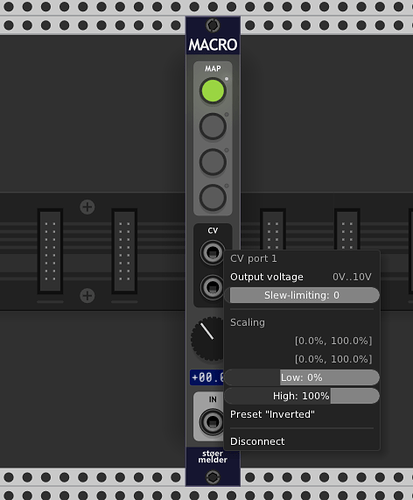Definitely check out MAZE if you haven’t already; HIVE is the same as MAZE except the original runs on squares whereas this variant runs on hexagons. All credit for the underlying concept goes to @stoermelder for sure, as well as for writing code that’s nice enough to allow me to extend it in this way without having a very clear idea of what I was doing at the start!
I think HIVE and MAZE look and work nice together in tandem, side-by-side. In that case I personally like to clock HIVE with multiples of 3 while clocking MAZE with multiples of 2. 
Some general thoughts on HIVE, for anyone curious:
I’ve been intrigued by hexagonal grids for about as long as I can remember, largely driven by experiences with strategy games played on hexagonally-gridded game boards: Battle for Wesnoth, Settlers of Catan, Civilization 5, and more recently abstract games from Nick Bentley like Bug, Circle of Life, and Blooms.
In scenarios like those involving strategic positioning and movement, the 6 degrees of hexagonal space create a significant impact in the structure, flow, feel, and apparent complexity of the game. Also, in my completely subjective opinion, hexagonal grids and the games played upon them have a striking visual appeal.
I was also driven by an interest in the interface between the visual appearance of a grid and the pitch/amplitude and rhythm information derived from it, as seen in MAZE. Using MAZE to make music involves beginning perhaps with a musical idea, translating that into intent visually upon MAZE’s grid, hearing a (likely unexpected) result, and finally the resultant sound feeds backward psychologically and informs our perception of the visual appearance of the grid, or at least that’s how it seems to me.
When a sequencer is also a visualizer, and sequences are programmed visually, and the sequencer has a bit of a mind of its own via randomization and probability, there seems to be a rich cyclic interaction between the aural and visual components of perception.
Playing with MAZE and then having the idea for HIVE provided me with a unique opportunity to explore that interest in hexagonal grids. I implemented it while wondering how that same sort of transformation from square to hexagonal in the strategy-space of a game might translate to some sort of an analogous transformation in the music-space of a sequencer, via MAZE’s laws of physics.
It also gave me an opportunity to explore the math behind implementing a hexagonal grid in code, which was for me equally fascinating. Who knew that a hexagonal grid can be thought of as a cube grid? Under-the-hood, HIVE’s coordinate system is derived from cube grid coordinates! If you’re interested in this sort of thing, I highly recommend this impressively thorough exploration from Red Blob Games. It’s got lots of enlightening interactive diagrams and animations.
After making HIVE, I started work on another module based on a hexagonal grid. I put a lot of time into it before switching gears and focusing Algomorph. Eventually I hope to get back to that and get it in working-order, so as to bring more hexagonal modules to the Library. 
(Hexagonal modules… I wonder if a hexagonal Eurorack case could be built in order to house modules with hexagonal face-plates. It would be more space efficient… I can dream.)
I’m so glad you’re enjoying HIVE @Eurikon ! Also a big thank you to Ben not only for all his modules, but also for making them open source so that others can learn from them like I have, and for accepting HIVE into the PackOne plugin. It’s truly an honor!





